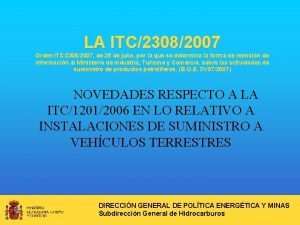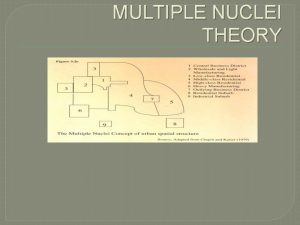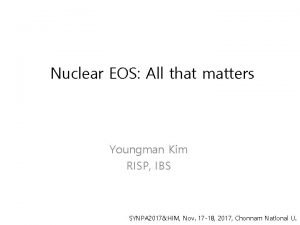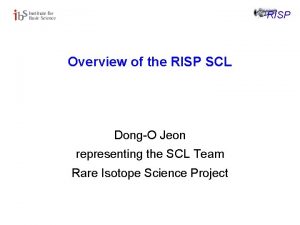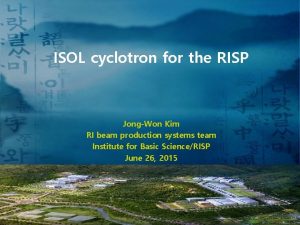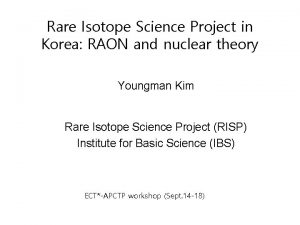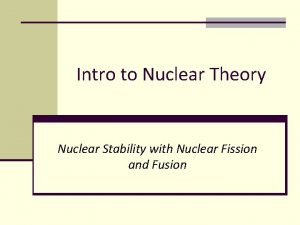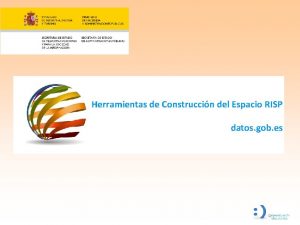Nuclear theory at RISP for RAON Youngman Kim
















- Slides: 16

Nuclear theory at RISP for RAON Youngman Kim Rare Isotope Science Project Institute for Basic Science, Daejeon, Korea


Ab initio No Core Shell Model for nuclear structure • Ab initio: nuclei from first principles using fundamental interactions without uncontrolled approximations. • No core: all nucleons are active, no inert core. • Shell model: harmonic oscillator basis • Point nucleons p n pπ p n π n n


Ik Jae Shin, Y. Kim, P. Maris, J. P. Vary, C. Forssén, J. Rotureau, N. Michel, J. Phys. G 44 (2017) 075103 Ab initio NCFC & ab initio GSM with a natural orbital single-particle basis

A. M. Shirokov, I. J. Shin, Y. Kim, M. Sosonkina, P. Maris, J. P. Vary, Phys. Lett. B 761 (2016) 87


W. -G. Paeng, B. -Y. Park, et al 0. 1

0. 16

0. 78

1. 17

1. 47

2. 43

<r-Process in the Core-collapsed Supernovae> Comparison between solar r-abundances and r-process abundance from two different scenarios 1) �� -driven wind model • We compare abundances from our network calculations with the solar rs/k=150, T(0)=8. 4 GK, Ye=0. 45, tau_dyn=0. 5 ms abundances in the reference, S. Goriely, Astron. Astrophys. 342, 881 (1999). • Here, the solar r-abundances are the relative amount of each element when the number of Si is 106. • We obtain r-process abundances from two different scenarios and normalize 2) Magnetohydrodynamic (MHD) jet our results to fix the abundance of 129 Xe=1. 08, in order to compare with solar abundances. • In the �� -driven wind model calculation, we use the exponential model with s/k=150. • The MHD jet trajectories which are obtained in the reference, S. Nishimura, et al. , Astrophys. J. 642, 410 (2006), are used.

<r-Process and Reaction Network> More than 2000 reactions are related to the network calculation!! Reaction networks at low mass region ref. ) Terasawa et al. APJ 562, 470 (2001) We change several reaction rates artificially and study the sensitivity of r-abundances in each scenario. u �� (�� n, �� )9 Be (x 10) 14 C(n, �� )15 C (x 10) u 15 C(n, �� )16 C (x 10) u 8 Li(�� , n)11 B u 13 C(�� , n)16 O (x 10) u 16 C(n, �� )17 C (x 10) u 14 C(�� , n)17 O (x 10) u 17 C(n, �� )18 C (x 10) u 13 C(n, (x 10) u �� )14 C (x 10) Reaction flows in the r-process

<Sensitivity of r-Abundances in the Artificial Change of Reaction Rates> 1) �� -driven wind model u 14 C(n, �� )15 C (x 10) u 15 C(n, �� )16 C (x 10) u 17 C(n, �� )18 C (x 10) 2) Magnetohydrodynamic (MHD) jet (x 10) u 8 Li(�� , n)11 B u (x 10) Difference [%] 14 C(�� , n)17 O Difference [%] u 13 C(�� , n)16 O (x 10)
 Mityc envio precios
Mityc envio precios Lesson 15 nuclear quest nuclear reactions
Lesson 15 nuclear quest nuclear reactions Fisión nuclear vs fision nuclear
Fisión nuclear vs fision nuclear Harris and ullman multiple nuclei model example
Harris and ullman multiple nuclei model example Young yun kim
Young yun kim Kontinuitetshantering
Kontinuitetshantering Typiska drag för en novell
Typiska drag för en novell Nationell inriktning för artificiell intelligens
Nationell inriktning för artificiell intelligens Returpilarna
Returpilarna Shingelfrisyren
Shingelfrisyren En lathund för arbete med kontinuitetshantering
En lathund för arbete med kontinuitetshantering Personalliggare bygg undantag
Personalliggare bygg undantag Tidbok yrkesförare
Tidbok yrkesförare Anatomi organ reproduksi
Anatomi organ reproduksi Densitet vatten
Densitet vatten Datorkunskap för nybörjare
Datorkunskap för nybörjare Stig kerman
Stig kerman
